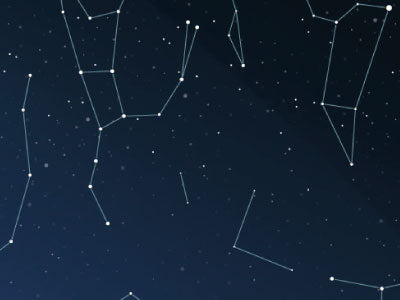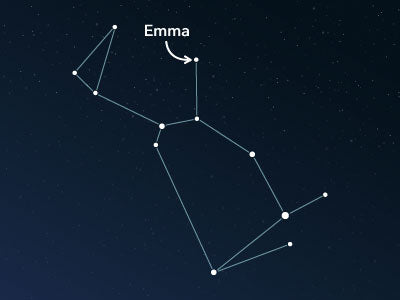The constellation Lupus
Caractéristiques
- Nom latin
- Lupus
- Hémisphère
- Hémisphère sud
- Visibilité
- April - September
- Région
- 334 deg²
- Étoile la plus brillante
- α Lupi (HIP number 71860)
- Spécialités
- Open star clusters, globular clusters, galaxies, planetary nebulae

The Lupus, Latin for Wolf, is an inconspicuous constellation in the southern celestial sky. It is one of the 48 ancient constellations that were spread by Claudius Ptolemy. In its area are several interesting deep-sky objects.
Hemisphere, visibility, and area
The constellation Lupus lies in the southern sky and can be observed from the entire southern hemisphere. North of the equator, it can only be seen up to the 35th parallel. This corresponds to regions such as Los Angeles or Oklahoma City in the United States, as well as the north of Morocco in West Africa or the island of Cyprus in the Mediterranean.
Around 2,000 years ago, the constellation could still be seen from parts of southern Europe, but due to the precession movement of the earth, Lupus is moving further south.
The best time to watch the constellation is between April and September, during which it appears with an area of approximately 334 square degrees in the night sky. With this size, Lupus ranks 46th among all the other 88 constellations.
In sky maps, Lupus is visualized with a variety of stars, but only three are brighter than 3 mags. The most shining star is α Lupi (Alpha Lupi), with an apparent magnitude of roughly 2.25. It is located approximately 465 light-years from earth.
Due to its faint stars, finding Lupus in the night sky can be challenging. The six surrounding constellations can therefore give a good orientation. To the north or northeast lie the striking Scorpius and Libra. Both constellations are located on the ecliptic and are particularly known in astrology. In the northwest, Hydra (often called water snake) can be found, and directly below it is the Centaurus. To the south and southeast, the Circinus and Norma constellations are adjacent.
Specialties in the constellation
The Milky Way stretches through the southern region of Lupus, which contributes to a series of nebulous objects. These include several globular clusters, open star clusters, galaxies, and planetary nebulae.
The brightest open star cluster is NGC 5822, with an apparent magnitude of about 6.5. It contains around 100 stars and is larger in size than the full moon. Its distance from earth is estimated to be approximately 2,500 light-years. NGC 5822 can be perceived as a hazy spot with the help of a prism binocular. The object lies in the southern area of the Lupus.
To the west lie two spiral galaxies and a planetary nebula. It is called Wolf-Rayet, Retina Nebula, or simply IC 4406. The nebula contains the hottest stars in the entire universe, and its distance to earth is approximately 5,000 light-years.
History
The constellation Lupus was already known in ancient times, but it received its current name only in the Middle Ages.
Initially, different creatures were interpreted in the constellation. The Babylonians saw the hybrid creature UR-IDIM, which has a human head and body but the limbs of a lion. The Greeks named it "Therion" (meaning "animal"), while the Romans gave the constellation the names "Fera" (meaning "wild animal") or "Hostia" (meaning "sacrificial animal"). In contrast, the Arabs saw the constellation as a leopard or panther.
The name "Wolf" first appeared on the Alphonsine tables around 1270. However, it was not until the 19th century that this name became more widely used.
Constellation Visibility Tool
Los Angeles, USA
34.05°, -118.24°
Constellation Observing Guide
This guide shows when the constellation is visible above the horizon and provides the optimal viewing window when the sky is darkest. Times are displayed in the location's timezone (PDT).
🎯 Best Observing Window
Optimal time when the constellation is fully visible AND the sky is at its darkest. Perfect for telescopic observations, astrophotography, and viewing faint details.
Optimal start
21:10
Jun 5, 21:10
Optimal end
01:09
Jun 6, 01:09
Duration
3.98h
Prime observing time
✨ Perfect Observing Conditions
This is the overlap when the constellation is above horizon AND the sky is at its darkest. Ideal for telescopic observations and photography.
Constellation Visibility from Your Location
12
Visible Stars
0
Never Rise
0
Always Up
100%
Visible
All stars of this constellation can be observed from your location
Constellation Visibility
When the constellation is above the horizon (includes daylight hours)
Rises
19:10
Jun 5
Fully Up
21:01 – 01:09
Jun 5
Starts Setting
01:09
Jun 6
Fully Set
04:02
Jun 6
Above Horizon Times
Includes daylight hours when stars aren't visible to naked eye.
Astronomical Night
When the sky is darkest (sun >18° below horizon)
Dark sky begins
21:10
Jun 5
Dark sky ends
04:40
Jun 6
Darkest Sky Period
Sun more than 18° below horizon. Best for faint objects.
Observing Tips
Lire d'autres articles intéressants

An overview of all 88 constellations
Learn more about all 88 constellations and read interesting information about the mythology, visibility, and features.

Application Planétarium
Découvrez le ciel nocturne avec notre application de planétarium !
Disponible pour iOS et Android.

Nommez une étoile dans la constellation Wolf
Name a star in a constellation and create something that lasts for eternity.